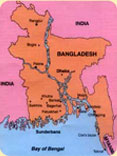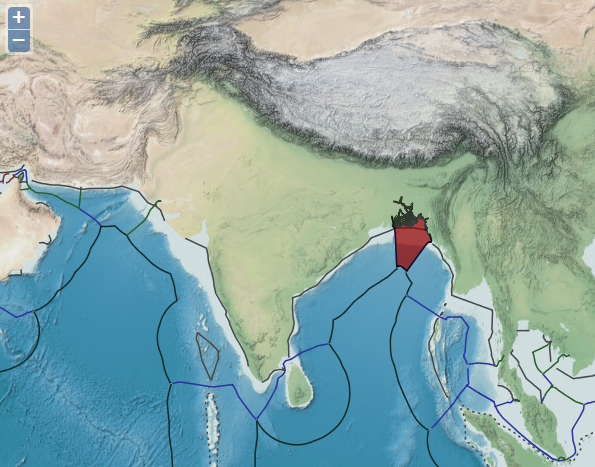| Aspects |
Profile |
| 1.Environment and major fish stocks |
Tropical multi-species fisheries spread over an EEZ of 118,000 sq. km (before settlement of maritime dispute with Myanmar and India). However, fishing effort is concentrated largely within 40 meters of depth. Hilsa and shrimp are the most important fisheries of Bangladesh. Other important fisheries include bombay duck, sardine and pomfret. |
| 2.Production and landings |
The marine fisheries production is 599,846 tons (2014-15) with an average annual growth rate of 2.39 percent during the last 10 years. Hilsa contributes about 42 percent of the landings and shrimps contributes about 8 percent of the landings. |
| 3.Fishing craft, technology & infrastructure |
Largely artisanal small-scale fishery. The marine fishing fleet comprises 243 industrial trawlers and 67,669 artisanal fishing fleet. Of the artisanal fishing fleet: 33,970 vessels are mechanized, while the rest are non-mechanized. Gillnetting contributes 55 percent of the total landings and trawling contributes 14 percent of the landings. Fishing is carried out from 14 coastal districts. There are only six fish landing centers (FLCs) operated by the BFDC in the country, viz. Chittagong, Cox’s Bazar, Khulna, Barisal, Patherghata and Khepupara. The lone fishing harbour of the country is located in Chittagong. The landing centres are poorly maintained and the connectivity is also far from satisfactory. There are a total of 100 active fish processing plants, 75 of which are EU approved. |
| 4.Post-harvest, trade and markets |
Per capita consumption of fish is 20 kg and its provides 60% percent of animal protein intake. Presently, about 55 to 65 percent of the fish are consumed fresh. Out of which 20-25 percent are without ice and 35-40 percent are with partial icing . 15-20 percent fish are cured or sundried (mostly low value species) and about 15-20 percent of the production is exported. Two major fishing seasons: late September to late March for Marine Set Bag Net (MSBN), Estuatrine Set Bag net (ESBN), beach seine and long line fishery for all fishes and the hilsa season from late March to Early October for gill net fishery. |
| 5.Economic aspects |
Fisheries contributed 3.69 percent of the GDP at 2004-05 prices in 2014-15 down from 3.79 percent in 2007-08. Sectoral growth also slowed down to 6.41 percent from 7 percent during the same period. In terms of employment the fisheries sector (including inland) engages 7.8 percent of the coastal households as per the 2001 population census. Bangladesh exports frozen shrimp and other fish and fisheries products to a number of EU member-countries, USA, Japan, Russia, Hong Kong, Saudi Arabia, Singapore and other countries where shrimps are exported. The total value of export in 2013-14 was 48.9822 billion BDT, increased from 33.5289 billion BDT in 2006-07. The entire shrimp aquaculture sector also depends upon on the marine sector for steady supply of berried penaeid shrimp to ensure supply of post-larvae. |
| 6.People, social aspects & human capacity |
There are about 516,000 active fishermen in the marine fisheries sector (2014). Traditionally, marine fishing was practiced at a subsistence level by the “Jaladas” belonging to the Hindu community. However, with the increased commercialization of marine fisheries and decrease in land assets because of population pressure, a large number of Muslim fishermen took up fishing as a full-time job. Most of the motorized small-scale fishing boat owners are now Muslims who hire Hindu or Muslim fishermen as crew, mostly on a catch-share basis. While fishermen earn better income now, they have low level of education and social status and lack organization. |
| 7.Organisations |
Department of Fisheries (DoF) under the Ministry of Fisheries & Livestock is responsible for fisheries management, trade and development. Bangladesh Fisheries Research Institute (BFRI) is mandated for fisheries research while Bangladesh Fisheries Development Corporation is responsible for infrastructure. DoF’s mission is to support sustainable growth in fish and shrimp production with other aquatic resources as well, for domestic consumption and exports, and management of open water fisheries resources through community participation leading to equitable distribution of the benefits generated, for optimal economic and social growth in Bangladesh. Mandate of the DoF relating to marine fisheries includes: (i) facilitating conservation and management measures; (ii) assisting the line Ministry in formulation of policies, acts, etc., (iii) quality control; (iv) fisheries resource survey; (v) arrangement of institutional credit; (vi) poor-centric alternative income generation activities and (vii) formulation and implementation of development projects. |
| 8.Institutions and law |
The governing act is Marine Fisheries Ordinance of 1983. The Government of Bangladesh has promulgated the Marine Fisheries Ordinance 1983 for conservation, management and development of marine fisheries resources. The major provisions of this Ordinance are: (i) License for fishing for all fishing vessels; (ii) Limiting the fishing days for shrimp trawlers and modern trawlers to 30 days in a cruise; (iii) banning discard of by-catch in shrimp trawlers; (iv) Control of mesh size for trawlers. Bangladesh Navy and Coast Guards are deployed to enforce the ban and provisions of the law routinely. However, trawlers associations have strongly contested this control. (v) shrimp and fish trawling is banned below 40 meters of depth; (vi) Compulsory use of TED; (vii) Declaration of Marine Reserves, and (viii) declaration of closed season for hilsa fishery. A number of rules related to fishers’ safety and seaworthiness of fishing vessels are implemented by the Mercantile Marine Department (MMD) of Bangladesh. The Bangladesh Fishing Vessel Equipment Rules, 2005 are a part of the Bangladesh Mercantile Shipping Ordinance, 1983. Bangladesh is also a signatory to the FAO’s Code of Conduct for Responsible Fisheries (CCRF) framed in 1995. But it is yet to implement its national CCRF with robust legal and institutional framework. However, poor implementation of law and development process has also led to erosion of local institutions. Especially, in open or non-enclosed waters where ‘enforcement’ by customary owners is more difficult, coastal dwellers have seen their traditional user rights progressively eroded in the face of commercial/industrial fisheries development, coupled with Governments’ fishery management policies that, overtly or tacitly, give recognition to the principles of open access and the right of ‘outsiders’ to fish in areas that were previously the domain of local residents. There are some areas where the traditional rights of coastal resource users remain in place, or are being re-established through community-based management arrangements. However, in many more areas traditional use rights have been replaced by essentially open access fisheries where local dwellers have no more rights than those from elsewhere. This has led to many examples of user conflict, especially where commercial/industrial fishermen from afar come to exploit the same resources that were harvested by the local artisanal fishermen. |
| 9.Fisheries Policy & Management |
In the Seventh Five-Year Plan (2016 -2020) document, emphasis has been laid on establishing a comprehensive plan for sustainable conservation, management and exploitation of resources. The strategies include: (i) rapid assessment of fisheries stocks by species in recently resolved South-West waters of EEZ (19,467 sq.km); (ii) formulation of National Marine Fisheries Policy; (iii) restriction and control on IUU fishing; (iv) identify conservation needs and implementable methods; (v) institutional capacity building of the concerned agencies, strengthening of MCS; (vi) promote development of technology for production of seed for culturing marine fish, and seaweed, and (vii) collaborative effort for distant water fishing (beyond 200 miles of EEZ and Area Beyond National Jurisdiction (ABNJ) to explore and exploit tuna and large pelagic fishes. 1198 FP |
| 10. Challenges and issues |
While marine fisheries production seems to be increasing steadily, different field studies shows that catch per unit of effort (CPUE) is declining. Falling catch rates, especially for hilsa, have led to implementation of strict seasonal controls. As a result, both stock status and landings have improved. However, a strong information collection methodology needs to be implemented to scientifically verify these claims as well as setting up a comprehensive management plan for improvement of fisheries and moving form an open access regime to regulated regime. A comprehensive management plan should also take into account vulnerability of the fishers and measures to address them. Other major challenges include optimizing fishing effort; curbing pollution; protecting coastal areas from adverse impact of urbanization; improvements in infrastructure facilities (FLCs and fishing Harbour); curbing use of destructive fishing gear; social security net to poor small-scale fishers; alternative livelihoods; and dealing with climate change. |








